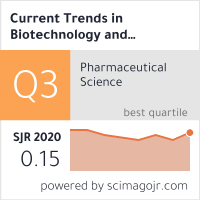”Insilco Evaluation of Psoralea corylifolia for Novel Anti-Tubercular Compounds: Virtual Screening, Molecular Docking, and Dynamics Simulation Analysis”
DOI:
https://doi.org/10.5530/ctbp.2024.3.39Keywords:
Insilico, Mycobacterium tuberculosis, Psorlea corylifolia, 2,4-Di-tert-butylphenol, Molecular Docking, Molecular Simulation, Anti-tubercular agentAbstract
Mycobacterium tuberculosis, the causative agent of tuberculosis (TB), remains a significant global health concern, causing millions of infections and deaths each year. The emergence of drug-resistant strains of M. tuberculosis has further complicated the treatment of this infectious disease. Therefore, there is an urgent need to discover new and effective therapeutic strategies to combat TB. P. corylifolia was reported to possess antibacterial, anti-inflammatory, antifungal, antioxidant, estrogenic, antitumor, and immunomodulatory activities. The present study aimed to conduct an insilico evaluation of phytochemicals from the plant Psorlea corylifolia that are retrieved from databases and literature against potential targets of Mycobacterium tuberculosis. Around 69 compounds belonging to the plant was collected from previous literatures and they were subjected to SwissADME screening with various filters like Lipinski, Ghose, etc. Seven compounds have crossed these filters and ADMET prediction was done for these compounds using online tools like PreADME, ADMETlab2.0, etc. Additionally, molecular docking was performed for all seven compounds against three potential targets: 6B2Q, 6R9W, and 5W25 (protein structures related to Mycobacterium tuberculosis). Among the tested compounds, 2, 4-Di-tert-butylphenol exhibited interactions with all three targets, demonstrating favourable binding energy. The best docked complex was selected for a 100ns molecular dynamics simulation, which revealed stability between 70-90ns, indicating its potential interaction within a virtual biological environment. Further this compound requires invitro testing to know its ability to act as an anti-tuberculosis agent. These findings contribute to the identification of promising lead compounds for future drug discovery efforts against Mycobacterium tuberculosis



